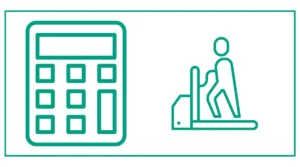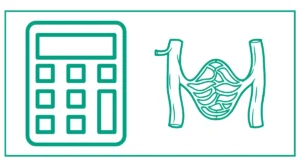The fat burning zone calculator helps you calculate your heart rate reserve, 60-80% of maximum heart rate, and fat burning zone by the Zoladz and Karvonen method.
Enter your age, resting heart rate (bpm), and maximum heart rate to find out the fat burning zone.
Heart rate reserve is the difference between your maximum and resting heart rates.
Zoladz Method: MAP helps find the heart rate deflection point (HRDP), which is used to find the power output’s functional threshold heart rate (LTHR or FTHR).
The Karvonen method, often known as the heart rate reserve (HRR) formula, uses the difference between your maximum and resting heart rates to calculate your HRR. HRR = HRmax – RHR (RHR).
You might be interested in Fasting or heart rate calculator.
In the quest for effective weight management and improved fitness, understanding the concept of the fat burning zone is crucial. This comprehensive guide will explore what the fat burning zone is, how to calculate it, and how to use this knowledge to enhance your workouts. We’ll also provide you with a practical fat burning zone calculator to help you determine your optimal heart rate range for fat burn.
What is the Fat Burning Zone?
The fat burning zone refers to a specific range of heart rates during exercise where your body is believed to burn the highest percentage of calories from fat. This zone typically occurs at a moderate intensity, usually between 60% to 80% of your maximum heart rate (MHR).
During exercises performed in this zone, your body relies more on fat stores for energy rather than carbohydrates. This makes the fat burning zone an attractive target for those looking to lose weight or improve their body composition.
How to Calculate Your Fat Burning Zone
To determine your fat burning zone, you first need to calculate your maximum heart rate. There are several methods to do this:
1. Age-Based Method
The simplest way to estimate your maximum heart rate is to subtract your age from 220. For example, if you’re 30 years old:
Maximum Heart Rate = 220 minus 30 = 190 beats per minute (BPM)
Once you have your MHR, you can calculate your fat-burning zone:
Fat Burning Zone = 60% to 80% of MHR
For our 30-year-old example:
- Lower end: 190 x 0.60 = 114 BPM
- Upper end: 190 x 0.80 = 152 BPM
So, the fat burning zone for this person would be between 114 and 152 BPM.
2. Karvonen Formula
For a more personalized calculation, you can use the Karvonen formula, which takes into account your resting heart rate (RHR):
- Calculate your Heart Rate Reserve (HRR) = MHR – RHR
- Fat Burning Zone = (HRR x 0.60 to 0.80) + RHR
Let’s say our 30-year-old has a resting heart rate of 70 BPM.
- HRR = 190 minus 70 = 120
- Fat Burning Zone:
- Lower end: (120 x 0.60) + 70 = 142 BPM
- Upper end: (120 x 0.80) + 70 = 166 BPM
3. Zoladz Method
Another approach is the Zoladz method, which provides a range based on your MHR.
Fat Burning Zone = MHR – 50 ± 5 BPM
For our 30-year-old example:
- Lower end: 190 minus 50 minus 5 = 135 BPM
- Upper end: 190 minus 50 + 5 = 145 BPM
Using the Fat Burning Zone Calculator
To make it easier for you to find your fat-burning zone, we’ve provided a calculator below. Simply enter your age, resting heart rate (if known), and maximum heart rate (if known), and the calculator will provide your fat-burning zone using multiple methods.
[Insert the provided calculator code here]
Benefits of Exercising in the Fat Burning Zone
Working out in the fat-burning zone offers several advantages:
- Increased fat utilization: Your body uses a higher percentage of fat for fuel in this zone.
- Improved endurance: Moderate-intensity exercise helps build cardiovascular fitness.
- Lower risk of injury: The lower intensity reduces stress on joints and muscles.
- Better workout sustainability: You can maintain this intensity for longer periods.
Incorporating Fat Burning Zone Workouts into Your Routine
To effectively use the fat-burning zone in your workouts:
- Start with a warm-up to gradually increase your heart rate.
- Aim for 30–60 minutes of exercise in your fat-burning zone.
- Use activities like brisk walking, jogging, cycling, or swimming.
- Monitor your heart rate using a heart rate monitor or by checking your pulse.
- Cool down gradually to bring your heart rate back to normal.
Remember, while exercising in the fat-burning zone can be effective for fat loss, it’s not the only way to burn fat. High-intensity interval training (HIIT) and strength training also play crucial roles in a comprehensive fitness program.
Measuring Your Heart Rate During Exercise
To ensure you’re working out in your fat-burning zone, you need to measure your heart rate. Here are some methods:
- Wearable devices: Smartwatches and fitness trackers can provide real-time heart rate data.
- Heart rate monitors: Chest strap monitors offer accurate readings.
- Manual pulse check: Count your pulse for 15 seconds and multiply by 4.
- Gym equipment: Many cardio machines have built-in heart rate sensors.
Common Misconceptions About the Fat Burning Zone
While the fat-burning zone is a useful concept, it’s important to address some misconceptions:
- It’s not the only way to burn fat. Higher-intensity exercises burn more total calories, including fat calories.
- Lower intensity doesn’t always mean more fat loss. overall calorie deficit is key for weight loss.
- It’s not suitable for everyone. Some people may benefit more from higher-intensity workouts.
A Comprehensive Approach to Fat Loss
While exercising in the fat-burning zone can be beneficial, it’s just one piece of the puzzle. To maximize fat loss and improve overall fitness, consider:
- Varying workout intensities: Include both low- and high-intensity exercises.
- Strength training: Building muscle increases your resting metabolic rate.
- Proper nutrition: A balanced diet is crucial for fat loss and overall health.
- Adequate rest and recovery: Allow your body time to repair and adapt.
References
- SYOUBO, A., SUSAKI, T., DEGUCHI, S., HIROSE, N., OKU, T., & TACHINO, K. (2011). Physiological Responses to Exercise Loads Set by the Karvonen Method. Rigakuryoho Kagaku, 26(1).
- Scharff-Olson, M. I. C. H. E. L. E., Williford, H. N., & Smith, F. H. (1992). The heart rate-VO2 relationship of aerobic dance: a comparison of target heart rate methods. The Journal of Sports Medicine and Physical Fitness, 32(4), 372-477.
- Banach, T., Grandys, M., Juszczak, K., Kolasińska-Kloch, W., Zoładź, J., Laskiewicz, J., & Thor, P. J. (2004). Heart rate variability during incremental cycling exercise in healthy, untrained young men. Folia medica Cracoviensia, 45(1-2), 3-12.





